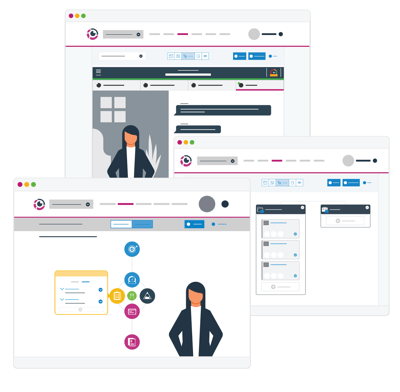For many organisations, the investment in Learning and Development can be a significant one. The time and financial commitment of planning the required learning across your workforce can be demanding and this is even more true when you need to create programs that will support you both now and in the future.
So how can you future proof your training, ensure you will be able to achieve your organisational goals and improve employee retention? Read on for our top tips.
Understand your learners
There is sometimes a perspective that your employees don’t want to engage with learning, but that’s actually not true. What people don’t want to engage with is irrelevant learning.
In reality, many employees are actually aware of their shortcomings and are actively trying to educate themselves. A Harvard Business survey found that 85% of employees felt confident in reporting their skills gaps and two thirds of them actively seek out learning.
-thumb.jpeg?width=460&name=Create%20better%20learning%20in%20a%20better%20way%20with%20PRODUCER%20(1)-thumb.jpeg)
Taking the time to understand your learners, what they want and how they want their learning can go a long way to future proofing your training and ensuring you can use learning to help you achieve your organisational goals.
Plan ahead
One of the best ways to future proof your learning is an obvious one—think ahead! Your learning should focus on where you need to be in 3–5 years. Ask yourself questions like: Where do I want me and my staff to be in five years? What skills do we need to get there? Once we're there, what will we need to support us? By looking both at your future needs and capability gaps, you’re naturally going to start aligning development planning to business needs.
As part of this, you might need to create parallel learning strategies that are dependent on scenarios. For example, what would happen if you opened a new office in a second city? What would happen if key people left their roles? What about in a business downturn and redundancies need to be made? Playing out a range of scenarios and aligning your L & D plans to support them is much more efficient (and often more cost effective) than scrambling to re- or up-skill your staff at the last minute.

So how can you know what the future looks like? In addition to staying on top of your industry magazines and research, one easily accessible crystal ball to view industry trends is job ads. If you had studied job advertisements over the past three years you would have noticed a trend of increasing weight being placed on skills like critical thinking (up 158%), team work (up 19%) and creativity (up 65%). Keeping an eye on the wider market and aligning your training is a good way of keeping your best staff from jumping ship to companies that offer them opportunities to grow their skills in new areas.
Invest in technology
Across the board, the uncertainty of business right now means that most people are needing to do more with less. This is even harder for your L & D team, as they are also responsible for upskilling employees to deal with the fact they need to do more with less.
Technology can be the key to this. Take the time to review your technology stack to see how it supports your actual development and if there are features that make it easy for you to scale this. Small things like allowing you to create your own themes and copy existing screens into new modules can all save you time and help you be more effective in focusing on the truly important things.

Adopt an 'always-on' approach
Traditionally, many organisations have approached learning on an ad hoc basis. Employees have undergone yearly reviews and their personal development goals have been set from there, giving limited opportunities for real learning. Similarly, compliance training has been treated as a tick box activity that needs to be completed.
Needless to say, this approach is outdated. Switching to an always-on approach to your learning encourages your employees to constantly be learning and reap the benefits. Supported by a learning culture, this on-demand learning means that people can find the information that they need when they need it.
Consider, for example, the difference between offering customer service training in a module accessible online verses including short customer service training in your company’s CRM. While this is an extreme example, focusing on having the learning where your learners are when they need it can vastly improve your learning outcomes and create a learning culture.
 Focus on learning transfer
Focus on learning transfer
One of the hardest things to deal with is when your well designed and engaging eLearning does nothing. Learners complete it, but the skills and knowledge included aren’t actually applied. This can also have a significant impact on your ROI, frustrating management and potentially risking the value of your training as a whole.
The good news is that it’s possible to change that by shifting your focus and including knowledge transfer in your development. By taking time to focus not only on the immediate time frame, but also on how you will support retention by offering opportunities for your learners to practice their skills and access support in the form of coaching and mentoring in the workplace is key to any successful workplace learning initiative.


